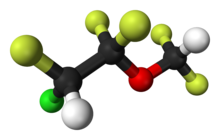Enflurane
 | |
 | |
| Clinical data | |
|---|---|
| AHFS/Drugs.com | Micromedex Detailed Consumer Information |
| ATC code | |
| Legal status | |
| Legal status | |
| Pharmacokinetic data | |
| Protein binding | 97% |
| Identifiers | |
| |
JSmol) | |
| |
| |
| (verify) | |
Enflurane (2-chloro-1,1,2-trifluoroethyl difluoromethyl ether) is a halogenated ether. Developed by Ross Terrell in 1963, it was first used clinically in 1966. It was increasingly used for inhalational anesthesia during the 1970s and 1980s[2] but is no longer in common use.[3]
Enflurane is a structural isomer of isoflurane. It vaporizes readily, but is a liquid at room temperature.
Physical properties
| Property | Value |
|---|---|
atm
|
56.5 °C |
| MAC | 1.68 |
| Vapor pressure at 20 °C | 22.9 kPa (172 mm Hg) |
Blood:gas partition coefficient
|
1.9 |
| Oil:gas partition coefficient | 98 |
Pharmacology
The exact mechanism of the action of general anaesthetics
Side effects
Clinically, enflurane produces a dose-related depression of
Enflurane also lowers the threshold for
Like the other potent inhalation agents it relaxes the uterus in pregnant women which is associated with more blood loss at delivery or other procedures on the gravid uterus.
The obsolete (as an anaesthetic) agent methoxyflurane had a nephrotoxic effect and caused acute kidney injury, usually attributed to the liberation of fluoride ions from its metabolism. Enflurane is similarly metabolised but the liberation of fluoride results in a lower plasma level and enflurane related kidney failure seemed unusual if seen at all.[14]
Occupational safety
The U.S.
References
- ^ Anvisa (2023-03-31). "RDC Nº 784 - Listas de Substâncias Entorpecentes, Psicotrópicas, Precursoras e Outras sob Controle Especial" [Collegiate Board Resolution No. 784 - Lists of Narcotic, Psychotropic, Precursor, and Other Substances under Special Control] (in Brazilian Portuguese). Diário Oficial da União (published 2023-04-04). Archived from the original on 2023-08-03. Retrieved 2023-08-16.
- ISBN 978-0-7817-5126-1.
- ISBN 9781437716795.
- ^ Perkins B (7 February 2005). "How does anesthesia work?". Scientific American.
- PMID 1667416.
- PMID 1326046.
- PMID 10683198.
- PMID 1331405.
- ^ ISBN 978-1-58811-124-1.
- ^ ISBN 978-1-4377-2792-0.
- ISBN 978-1-4698-3027-8.
- S2CID 1050582.
- doi:10.15363/thinklab.d224. Archived from the originalon October 18, 2016. Retrieved October 17, 2016.
- ^ Morgan GE, Mikhail MS, Murray MJ, Larson CP (September 2006). Clinical Anesthesiology (3rd ed.). New York: Lange Medical Books/McGraw-Hill. p. 142.
- ^ "CDC - NIOSH Pocket Guide to Chemical Hazards - Enflurane". www.cdc.gov. Retrieved 2015-10-01.
